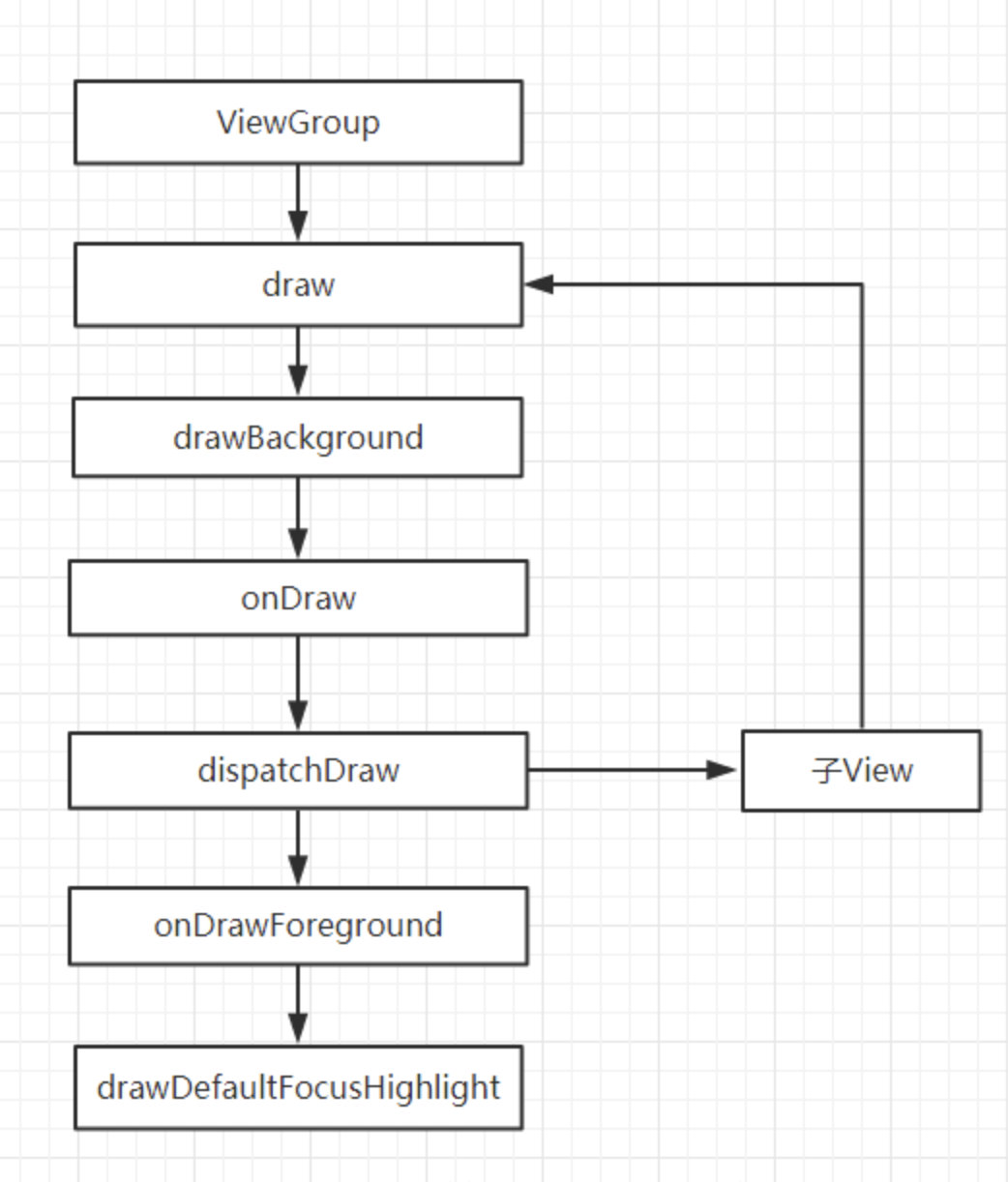本文主要是梳理 View 绘制的整体流程,帮助开发者对 View 的绘制有一个更深层次的理解。
整体流程
View 绘制中主要流程分为measure,layout, draw 三个阶段。
- measure :根据父 view 传递的 MeasureSpec 进行计算大小。
- layout :根据 measure 子 View 所得到的布局大小和布局参数,将子View放在合适的位置上。
- draw :把 View 对象绘制到屏幕上。
那么发起绘制的入口在哪里呢?
在介绍发起绘制的入口之前,我们需要先了解Window,ViewRootImpl,DecorView之间的联系。
一个 Activity 包含一个Window,Window是一个抽象基类,是 Activity 和整个 View 系统交互的接口,只有一个子类实现类PhoneWindow,提供了一系列窗口的方法,比如设置背景,标题等。一个PhoneWindow 对应一个 DecorView 跟 一个 ViewRootImpl,DecorView 是ViewTree 里面的顶层布局,是继承于FrameLayout,包含两个子View,一个id=statusBarBackground 的 View 和 LineaLayout,LineaLayout 里面包含 title 跟 content,title就是平时用的TitleBar或者ActionBar,contenty也是 FrameLayout,activity通过 setContent()加载布局的时候加载到这个View上。ViewRootImpl 就是建立 DecorView 和 Window 之间的联系。
这三个阶段的核心入口是在 ViewRootImpl 类的 performTraversals() 方法中。
1 | private void performTraversals() { |
在源码中这个方法贼长,但是核心还是这三个步骤,就是判断根据之前的状态判断是否需要重新 measure,是否需要重新 layout ,是否需要重新 draw。
measureSpeac
在介绍 measure 方法之前,需要了解一个很核心的概念:measureSpeac 。在 Google 官方文档中是这么定义 measureSpeac 的
A MeasureSpec encapsulates the layout requirements passed from parent to child. Each MeasureSpec represents a requirement for either the width or the height. A MeasureSpec is comprised of a size and a mode.
大概意思是:MeasureSpec 封装了从父View 传递给到子View的布局需求。每个MeasureSpec代表宽度或高度的要求。每个MeasureSpec都包含了size(大小)和mode(模式)。
我觉得这是measureSpeac 最好的解释了。
后面两句不难理解。MeasureSpec 一个32位二进制的整数型,前面2位代表的是mode,后面30位代表的是size。mode 主要分为3类,分别是
EXACTLY:父容器已经测量出子View的大小。对应是 View 的LayoutParams的match_parent 或者精确数值。
AT_MOST:父容器已经限制子view的大小,View 最终大小不可超过这个值。对应是 View 的LayoutParams的wrap_content
UNSPECIFIED:父容器不对View有任何限制,要多大给多大,这种情况一般用于系统内部,表示一种测量的状态。(这种不怎么常用,下面分析也会直接忽略这种情况)
封装了从父 View 传递给到子 View 的布局需求,这句话又怎么理解呢?
View 的 MeasureSpec 并不是父 View 独自决定,它是根据父 view 的MeasureSpec加上子 View 的自己的 LayoutParams,通过相应的规则转化。
看代码:
View 测量流程是父 View 先测量子 View,等子 View 测量完了,再来测量自己。在ViewGroup 测量子 View 的入口就是 measureChildWithMargins
1 | protected void measureChildWithMargins(View child, |
通过代码我们很可以很看到 View 的子 View 的 MeasureSpec 转化规则,但是感觉可能有点懵,我们用一个”商城-衣服”例子来比喻一下:
我们把父 View 看做成商城,子 View 看做成衣服,EXACTLY / MATCH_PARENT 看做成高档品牌,AT_MOST / WRAP_CONTENT 看做成杂牌,精确值看做成价格,View的大小看做价格。
如果是衣服(子 View)产地是高档品牌(LayoutParams = LayoutParams.MATCH_PARENT),商城是(父 View)高档的商城(EXACTLY),那么衣服的价格(size 大小)就会根据高档商城价格来定,能有多高就卖多高(View的大小取决于父View大小)。
如果是衣服(子 View)产地是高档品牌(LayoutParams = LayoutParams.MATCH_PARENT),商城是(父 View)杂牌的商城(AT_MOST),那么衣服的价格(size 大小)也会根据低档商城价格来定,太高普通人也买不起呀(View的大小取决于父View大小)。
如果是衣服(子 View)产地是杂牌(LayoutParams = LayoutParams.WRAP_CONTENT),商城是(父 View)高档的商城(EXACTLY),那么衣服的价格(size 大小)也会根据高档商城价格来定,能有多高就卖多高,毕竟店大欺人,绝不打折(View的大小取决于父View大小)。
如果是衣服(子 View)产地是杂牌(LayoutParams = LayoutParams.WRAP_CONTENT),商城是(父 View)杂牌的商城(AT_MOST),那么衣服的价格(size 大小)就会根据低档商城价格来定,小巷步行街不都是这样卖的吗(View的大小取决于父View大小)
如果是衣服(子 View)已经全国明码标价(android:layout_xxxx=”200dp”),商城是(父 View)无论是杂牌的商城(AT_MOST)还是高档的商城(EXACTLY),那么衣服的价格(size 大小)就不会变的。,不然打你小屁屁。
如果你觉得例子真的糟糕透了,那么看以下一表正经总结:
一表正经总结以下:
当父View的mode是EXACTLY的时候:说明父View的大小是确定的
- 子View的宽或高是MATCH_PARENT:
- 子View的宽或高是WRAP_CONTENT:子View是包裹布局,说明子View的大小还不确定,所以子View最大不能超过父View的大小mode=AT_MOST。
- 子View的宽或高是具体数值:子viewd大小已经固定了,子View的大小就是固定这个数值,mode=EXACTLY。
当父View的mode是AT_MOST的时候:说明父View大小是不确定的。
- 子View的宽或高是MATCH_PARENT:父View大小是不确定的,子View是填充布局情况,也不能确定大小,所以View大小不能超过父View的大小,mode=AT_MOST
- 子View的宽或高是WRAP_CONTENT:子View是包裹布局,大小不能超过父View的大小,mode=AT_MOST。
- 子View的宽或高是具体数值:子viewd大小已经固定了,子View的大小就是固定这个数值,mode=EXACTLY。
需要注意一点就是,此时的MeasureSpec并不是View真正的大小,只有setMeasuredDimension之后才能真正确定View的大小。
measure
measure 主要功能就是测量设置 View 的大小。该方法是 final 类型,子类不能覆盖,在方法里面会调用 onMeasure(),我们可以复写 onMeasure() 方法去测量设置 View 的大小。
1 | public final void measure(int widthMeasureSpec, int heightMeasureSpec) { |
在 onMeasure( ) 方法中
1 | protected void onMeasure(int widthMeasureSpec, int heightMeasureSpec) { |
onMeasure( ) 方法就是执行测量设置 View 代码的核心所在。
我们先来看下 getSuggestedMinimumWidth()
1 | protected int getSuggestedMinimumWidth() { |
这里返回的建议最小值就是我们xml 布局中用的属性 minWidth或者是背景大小。
同理可得 getSuggestedMinimumHeight()。
看下 getDefaultSize
主要作用就是根据View的建议最小值,结合父View传递的measureSpec,得出并返回measureSpec
看代码
1 | public static int getDefaultSize(int size, int measureSpec) { |
getDefaultSize 的逻辑跟我们之前分析的 MeasureSpec 转化规则非常相似。就是根据specMode设置大小。如果specMode是UNSPECIFIED 未确定大小,则会使用建议最小值,如果其他两种情况,则使用父View传递过来的大小。再次强调:并不是父View 独自决定,它是根据父 view 的MeasureSpec加上子vIew的自己的LayoutParams,通过相应的规则转化而得到的大小。
再来看下 setMeasuredDimension
setMeasuredDimension 作用就是将测量好的宽跟高进行存储。在onMeasure() 必须调用这个方法,不然就会抛出 IllegalStateException 异常。
我们重新梳理一下刚才那些流程:
在measure 方法,核心就是调用onMeasure( ) 进行View的测量。在onMeasure( )里面,获取到最小建议值,如果父类传递过来的模式是MeasureSpec.UNSPECIFIED,也就是父View大小未定的情况下,使用最小建议值,如果是AT_MOST或者EXACTLY模式,则设置父类传递过来的大小,然后调用setMeasuredDimension 方法进行存储大小。
layout()
作用描述
measure() 方法中我们已经测量出View的大小,根据这些大小,我们接下来就需要确定 View 在父 View 的位置进行排版布局,这就是layout 作用。
对 View 进行排版布局,还是要看父 View,也就是 ViewGroup。
看代码
1 |
|
代码不多,大致作用就是判断 View 是否在执行动画,如果是在执行动画,则等待动画执行完调用 requestLayout(),如果没有添加动画或者动画已经执行完了,则调用 layout(),也就是调用View的 layout()。
1 | public void layout(int l, int t, int r, int b) { |
View 的 layout 的方法也是非常长。大致作用就是设置 View 的在父 View 的位置,然后判断位置是否发生变化,是否需要重新调用排版布局,如果是需要重新布局则用了 onLayout()方法。
在OnLayout 方法中,View 里面是一个空实现,而 ViewGroup 则是一个抽象方法。为什么这么设计呢?因为onLayout中主要就是为了给遍历View然后进行排版布局,分别设置View在父View中的位置。既然如此,那么View的意义就不大了,而ViewGruo 必须实现,不然没法对子View进行布局。那么如何对 View 进行排版呢?举例个简单的demo。
1 | protected void onLayout(boolean changed, |
就是遍历所有的子 View 然后调用 child.layout(l, t, r, b)。
大家有兴趣也可以参考一下 FrameLayout, LinearLayout这类布局。
draw()
经过前面两部的测量跟布局之后,接下来就是绘制了,也就是真正把 View 绘制在屏幕可见视图上。draw()作用就是绘制View 的背景,内容,绘制子View,还有前景跟滚动条。看下 View 的draw() 源码
1 |
|
draw 过程中一共分成7步,其中两步我们直接直接跳过不分析了。
第一步:drawBackground(canvas): 作用就是绘制 View 的背景。
第二步:onDraw(canvas) :绘制 View 的内容。View 的内容是根据自己需求自己绘制的,所以方法是一个空方法,View的继承类自己复写实现绘制内容。
第三步:dispatchDraw(canvas):遍历子View进行绘制内容。在 View 里面是一个空实现,ViewGroup 里面才会有实现。在自定义 ViewGroup 一般不用复写这个方法,因为它在里面的实现帮我们实现了子 View 的绘制过程,基本满足需求。
第四步:onDrawForeground(canvas):对前景色跟滚动条进行绘制。
第五步:drawDefaultFocusHighlight(canvas):绘制默认焦点高亮。

好了,整个绘制流程就分析完毕了!

